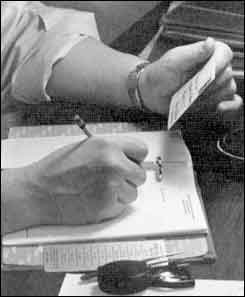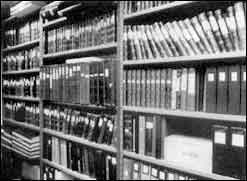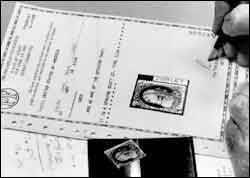 |
 |
 |
 |
Expertizing > The Process >The Expertizing ProcessWhen stamps and covers arrive at The Philatelic Foundation for expertizing, their first stop is with the Office Manager, who immediately receipts and records each item. The application forms for certificates of opinion are checked to make certain they are complete and accurate. The data on the application is entered into the computer data-base, and each application is assigned a unique number which will stay with the "patient" until the certificate is issued. This keeps the identity of the owner confidential from expertizers and consultants. Color scans of the items are next. These will serve to document the item on the certificate itself, and in the reference files of the PF. 
The worksheet for each item is prepared. This holds the item, its submitted or tentative identification and any preliminary notes by the staff, requests from the submitter, and other materials including references. The "patient" and the worksheet then go to the experts. At this point, The Philatelic Foundation's expert curators and visiting consultants go to work. Over a period of days or weeks, the appropriate experts examine the "patients" and give their individual opinions. In one recent period, it was calculated that an average of 4.6 of the country's top philatelists, amateur or professional, examined the average patient. For particularly difficult items, the PF will search out and consult the top experts on the subject, anywhere in the world. The Philatelic Foundation has numerous resources available to those who examine the material. The state-of-the-art scientific equipment includes binocular and comparison microscopes, paper micrometers, and ultraviolet and infrared energy sources. The Expert Committee also has access to photometric color determination, x-ray fluorescence and spectro-photometry. 
The reference library, reference notes and certificate photo files of The Philatelic Foundation are unique sources of information, available to the experts, consultants and staff as well as to serious outside researchers. Over the years, the PF has become the repository of several sets of records that are unique or nearly so. These include photographs or photocopies of many major one-issue collections (the names of the owners are a virtual "who's who" of nearly a century of American philately) as well as important world-wide holdings (e.g. the Caspary collection). Other indispensable troves include the Stanley B. Ashbrook research notes, card files and letters, the John Luff reference collection (used as the basis for many of the listings in the Scott catalogs) and correspondence and clipping files supplemented by complete records (including photographs) of every stamp certified by the PF since 1945. These records have helped verify the existence of newly-listed plate varieties and aided researchers in compiling censuses of known copies of rare stamps or covers. The reference collections, library (well over 5,000 volumes plus thousands of important auction catalogs) and clipping files are not limited to United States stamps. The PF is rich in references for Central and South America, Europe East and West and several other areas, with particular emphasis on Classic issues. The PF has established an Acquisition Fund for obtaining further reference items crucial for its ongoing expertizing activities. 
When the examination of any given "patient" is complete, the final opinion is determined and entered on the worksheet. This includes identification, mechanical condition and any remarks regarding special features or alterations. Then, a certificate is printed, impressed with the PF seal, and the item and certificate are subjected to a final review. Only then is the certificate personally signed by the Chairman of the Expert Committee, and the items packaged and returned by the submitter. All items are insured while at The Philatelic Foundation and during their return to the owners. Currently, the entire process averages about 5 to 6 weeks, though in the case of very specialized or unusual items, it may take a little longer. Though this time frame may seem long to an anxious owner, submitters are reminded of the adage, "Good food takes time." The strict record-keeping and integrity required by the Philatelic Foundation's charter and mission statements and its efforts to obtain the best possible opinions for all items do require diligence and deliberation - and the time to carry them out. With an error rate (items whose opinions were materially reversed on reconsideration or subsequently proven to be not as certified) of far less than one percent, The Philatelic Foundation is proud to stand on its record as the premier certification service world-wide. |
The Philatelic Foundation is located at 341 West 38th Street, 5th Floor, New York, NY 10018 Copyright 2005 - by The Philatelic Foundation, all rights reserved.
|
| Home | What's New | Expertizing | Why Expertize? | History | Educational Resources Publications | Who's Who | Become a Contributor | Contact The PF Application for a Certificate |